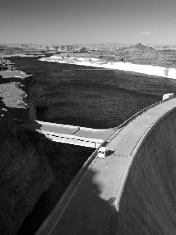by Joe Stone
Colorado’s temperatures will rise over 4°F by the year 2050. Mountain snowpack will melt earlier, and stream flows in the Colorado River Basin will diminish by five to 20 percent. These numbers, highlighted in October, 2008 at the Governor’s Conference on Managing Drought and Climate Risk, are documented in a report titled Climate Change in Colorado. Published by Western Water Assessment,* the report identifies several issues that will challenge Colorado’s ability to meet water demands as temperatures increase.

While these findings have received significant publicity, a short section near the end of the report seems to have gone unnoticed. Titled “Key Unresolved Issues,” this section reads, “The current state of the science is unable to provide sufficient information to decision makers and stakeholders on a number of crucial scientific issues regarding Colorado’s water resources …. four overlapping areas with unresolved issues are climate models, research specific to Colorado, [understanding] drought, and reconciling hydrologic projections.”
In other words, significant uncertainties exist in the scientific basis of projected climate changes and how those changes might affect Colorado’s water supply. Even without a lack of information on “crucial scientific issues,” the idea of planning for future statewide water needs based on a 50-year weather forecast seems a bit sketchy, which begs the question, “What do we actually know about Colorado’s climate and its impact on our water supply?”
First, we know that temperatures in Colorado have increased by about 2°F since 1977. We also know that, since 1978, the onset of spring streamflows from snowmelt has shifted earlier by about two weeks. Both of these facts support the forecasts published in the WWA report, but 30 years is not very long in a climate that has weathered numerous ice ages. Gauge records document Colorado streamflows back to the late 1800s, and according to the WAA report, “reveal no significant streamflow trends in the past 60 years.”
Based on these recorded facts, most of us would be tempted to ask what all the fuss is about; but before we throw the scientists out with the bathwater, it might pay to read one of the report’s sidebars entitled “Paleoclimate.” Paleoclimatologists study various environmental indicators to reconstruct climate conditions extending back hundreds of years. Tree growth, for example, accurately reflects moisture availability, and tree-ring data provides a key information source for reconstructing Colorado River Basin streamflows over the past 1200 years.
The 1200-year paleoclimate record indicates that severe and sustained droughts occurred across the western states. Eight droughts have occurred over the past 500 years that were similar in severity to the 2000–2004 drought, but even these climate events pale in comparison to a 57-year drought that occurred during the mid-1100s. Two extended drought periods also occurred in the 800s, including one that lasted for 25 years. A number of other environmental indicators confirm that drier conditions prevailed across the western states from about 800 to 1300.
Examining the paleoclimate record demonstrates that droughts more severe than any in the historical record are relatively common and that water allocations in Colorado and other western states were based on one of the wettest periods in the past 12 centuries. Colorado has already exceeded its allotments on the Arkansas and South Platter rivers, and another drought like the one in 2000 would likely force Colorado water managers to release water for downstream users in the Colorado River Basin.
Threats to Colorado’s existing water resources from invasive species (like tamarisk, Russian olive, Eurasian milfoil and zebra mussels) exacerbate water issues as do water losses from aging, leaking infrastructure. The current economic climate will make it increasingly difficult for water providers to secure financing for infrastructure repairs and source water development, which is a huge concern in light of Colorado’s rapid population growth. By 2030, Colorado is expected to have an additional 2.8 million residents, and most of that growth will come from within (DOLA statistics). Demographers estimate that the Arkansas Basin population will increase by 55 percent in the next 20 years, placing greater demands on the state’s most over-allocated river. In fact, Colorado’s population growth may be the most significant factor affecting our water supply.
Relying on good scientific information to make water management decisions makes sense, and we do not have to look far to find ample and alarming evidence that Colorado’s water supply is threatened not only by a drought-prone climate but also by overpopulation and invasive species. Besides motivating us to safeguard our water supply through strict conservation measures, this information also suggests that our scientific research dollars would be better spent on hard science (like expanding the paleoclimate information base) and fieldwork (like tamarisk eradication) than on the cubicled geekdom of computer-simulated climate models.
*Western Water Assessment is a collaboration between the University of Colorado and the National Oceanic and Atmospheric Administration.
Joe Stone is a freelance writer from Salida whose writing career began at “the atomic city,” Oak Ridge, Tennessee. Seven years at Oak Ridge National Lab taught Joe more than he ever wanted to know about environmental issues and government bureaucracy.


